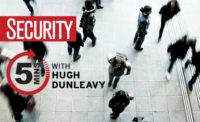
There
are more than one million private security officers and the profile continues
to improve in terms of training and diverse assignments. Photo courtesy of
AlliedBarton
There are more than one million people employed as security officers in the United States, according to the latest information from the Bureau of Labor Statistics, U.S. Department of Labor. Other experts suggest that number could be more the 1.2 million. With combined revenue of about $15 billion, there are around 10,000 to 12,000 firms providing contracted officers, although only a couple of dozen have geographic coverage enough to have a significant marketshare.
Security officers patrol and inspect property to protect against fire, theft, vandalism, terrorism and illegal activity. They protect their employer’s investment, enforce policies and laws on the property and deter negative activity and other problems.
Although all security officers perform many of the same duties, their specific duties vary with whether the officer works in a “static” security position or on a mobile patrol. Officers assigned to static security positions usually serve at one location or modular guardhouse or post for a specified length of time. Often they monitor alarms and security video. In contrast, officers assigned to mobile patrol duty drive, Segway, bike or walk from location to location and conduct security checks within an assigned geographical zone.
Most states require that private security officers licensed. Officers in certain areas such as colleges and universities may be sworn law enforcement officers. To be licensed as a private security officer, individuals must usually be at least 18 years old, pass a background check and complete classroom training in such subjects as property rights, emergency procedures and detention of suspected criminals. Drug testing often is required and may be random and ongoing.
The appropriate government authority must license officers who may carry weapons, and some receive further certification as special police officers, allowing them to make limited types of arrests while on duty. Armed positions have more stringent background checks and entry requirements than those of unarmed guards because of greater insurance liability risks. Security Magazine research shows that, often, chief security officers will specify contracted armed officers for the higher-level training even though the officers will not be armed.
Rigorous hiring and screening programs consist of background, criminal record and fingerprint checks.
Because many people do not stay long in this occupation, opportunities for advancement are good for those who are career security officers, according to Department of Labor research. Some of the above information from the Bureau of Labor Statistics, U.S. Department of Labor, Occupational Outlook Handbook, 2006-07 Edition, Security Guards and Gaming, on the Internet at http://www.bls.gov/oco/ocos159.htm.

Quality Over Quantity:Training Certification Matters
By William C. Whitmore Jr., Contributing WriterThe debate is on.
Proposed minimum training hours in our industry are hotly discussed among trade organizations, legislators, regulators, unions and the media. All in all, the hope is that enhanced training will equip security officers with the tools they need to be effective, educated and prepared, especially in the event of a national emergency.
While legislation on training standards is without question a step in the right direction, there is an obvious flaw with simply mandating a certain number of hours without focusing on the quality of the curriculum. Given that officers must master a gamut of skills, it is more critical than ever that the industry move away from measuring training strictly by hours. The industry needs to introduce an industry-wide training solution that will also measure the quality of training that employees are receiving.
The industry has spent too much time on the quantitative particulars – like classroom hours and trainer requirements – rather than creating a mechanism that will qualitatively measure the competency of every single officer in the industry. The solution: assure that all officers (both proprietary and contract) are certified to perform the duties for which they have been employed. Certification will professionalize the entire industry, as it will attract, provide greater rewards and open doors to more long-term career opportunities.
STANDARDIZATION IN PLACE
The accounting industry is a good example to follow. According to the Certified Public Accountant (CPA) Examination Mission Statement, the purpose of the Uniform CPA Examination is “to admit individuals into the accounting profession only after they have demonstrated the entry-level knowledge and skills necessary to protect the public interest in a rapidly changing business and financial environment.” Upon passing the examination, CPAs receive tangible benefits in the form of increased compensation (CPAs are paid approximately ten percent more than non-certified accountants). Plus, they earn intangible benefits like added respect and increased pride in their jobs.
Ultimately, if the security industry implemented such a system, the professionalism and quality of the entire industry would rise. From a corporate perspective, a certification system would drive better training programs into the industry. Proprietary and contract organizations would be held to higher standards and would be required to train officers to the maximum possible standards. If officers from a particular organization began failing a certified test, it should significantly impact a company’s financials and reputation.
With a regimented certification-testing program in place, companies should be able to attract a higher caliber employee, which would also aid in combating the high turnover that blemishes the industry. Furthermore, such a system would emphasize the security industry’s long-term career potential. Officers that invest time and energy in passing a training examination would be more likely to see the security industry as a career option versus a part-time job. Companies should be willing to offer additional promotion opportunities to those officers who pass a certified examination.
In the end, it is really the officers who will benefit most from certified testing by independent organizations. Their training programs should be more vigorous in content and better prepare them for on-the-job duties. And upon passing an examination, officers would earn more, have added respect among peers and superiors as well as increased pride in their jobs.
It is a time for urgency and for leadership to stand up against the perception that the industry employs low wage, under-trained workers. Time is ticking, and we have to seize this opportunity and prove that our industry can set the standard for training.

“It’s
time to qualitatively measure officers,” contends AlliedBarton CEO William
Whitmore.
William (Bill) C. Whitmore, Jr., is CEO of AlliedBarton Security Services, the nation’s largest independently owned security officer services company. Contact him at Bill.Whitmore@AlliedBarton.com or visit www.alliedbarton.com.

Security
officers in retail situations are there to provide customers what they want and
where and when they want it. “It’s customer service,” according to David
Levenberg.
My Turn: Officers in Retail, Malls Face Unique Duty
David Levenberg, CPP, vice president of security and loss prevention, General Growth Properties, Inc., knows his business mission – to provide customers what they want and where and when they want it. “It’s customer service and I have to make sure that that security force is customer-focused.”General Growth Properties, Inc. is the second largest U.S.-based publicly traded Real Estate Investment Trust (REIT). It has an ownership interest in or management responsibility for a portfolio of more than 200 shopping malls in 44 states, as well as ownership in planned community developments and commercial office buildings.
For over two decades, Levenberg has managed and participated in the design and implementation of loss prevention and public safety programs in both retail and shopping center properties nationally and internationally. As the vice president of security for General Growth Properties, Inc., he is responsible for guiding the public safety, loss prevention and emergency planning programs for over 200 regional and super regional shopping centers.
In many assignments, he uses contract officers from Valor. In the retail environment, security officers are the most visible indication of security the customer help. Training is very important to him. “There are core training requirements including report writing, patrol techniques, investigation of incidents and accidents. We track our incidents via a Web-based system down to the mall level.” Levenberg analyzes incidents and activity. “Liability costs to our contract guard service translate to costs to us.” That is particularly important with officers in vehicles. “Defensive driving is a standard. Some vehicles have installed cameras that can film when there is an impact.”

The
officer mission has gone beyond patrols. Employees, customers, visitors and
executives now seek out security officers for information and help. Photo
courtesy of Valor
- Security director
- Assistant security director
- Security supervisors
- Security video operators/dispatchers (if applicable)
- Security officers
General Growth deploys proven security technology and equipment designed to emphasize a security presence at many of its centers.
- Pan/tilt/zoom (PTZ) digital cameras covering parking lots, mall entrances, mall common areas, public restroom hallways, escalators and loading docks.
- Digital video recorders (DVR) capable of continuous recording of all cameras and speedy searches and video retrieval.
- Use of DVR analytic technology, such as security video motion detection at mall entrances.
- Public access automated external defibrillators located on property.
- Typical patrol equipment including security equipped SUVs and bicycles.

Custom
consoles such as the Talon2 provide better effectiveness for the officers
monitoring security video and other alarms. The concept behind this custom
console is to mount 40"+ monitors on a free-standing/self supporting
platform.
Video Monitoring Tasks Stress Better Consoles
There is a strong trend to customized consoles and displays to make it more efficient for security officers who are monitoring these systems.According to Huckleberry Starnes of Winsted Technical Interiors, “Our cust- omers are those who are looking for one of the three requirements from their console/control room: 1. Complex, large or unusual equipment configuration that will not work with a off the shelf product. 2. Installation location that is specialized concerns (seismic, fire load, etc.) oddly shaped or that the customer is trying to pack a lot of equipment into a small space. 3. Customer looking for a "company specific" or branded identity from their console or those looking for a higher grade of finish and materials.”
Starnes believes that, for security officers monitoring systems, one of the biggest trends right now in security video is the switch from CRTs to flat panel displays or FPDs. Not only are people updating their technology, but also adding screens and cameras as the costs go down. For this reason they also need to update their consoles to one that was designed specifically for FPDs and to deal with the large number of mounts to be used on it. “This alteration in the use of consoles directly impacts the ergonomics of the user and can have very negative consequences on the the comfort/performance of the user if not set up properly,” said Starnes.
Winsted Technical Interiors is a full service design & build firm resulting in turn key solutions.

Universal
Protection Officer Ed Llamas was instrumental in apprehending copper thieves at
the South Bay Development Company’s recently purchased building.
Coppers After Copper Thieves
The South Bay Development Company purchased an abandoned 80,000 square foot manufacturing building in Fremont, Calif., approximately 30 minutes north of South Bay’s office. Little did they know that the building would fall victim to copper theft. The building, as well as several others owned by South Bay throughout Silicon Valley, had the repeated problem of copper wiring being stripped from buildings. The wire theft caused damage to electricity and air conditioning units, resulting in hundreds of thousands of dollars in losses.This particular building, due to its former function as well as its large size, made it a prime target for copper theft. However, because of its distance from the South Bay office, it could not be effectively monitored without assistance.
AN EFFECTIVE APPROACH
The building was broken into only 30 short days after purchasing, so South Bay contracted Universal Protection Service, who had performed patrol services for South Bay in the past at other facilities. The patrols were scheduled at various times throughout the day, with a report being made after each visit. However, thefts were still occurring without any capture or assailants identification.
As a result, South Bay property owner, Dave Andris, met with several Universal Security Professionals to develop a more effective approach. Regular patrol visits were scheduled during the more vulnerable times of the day. A guard tour verification system was also installed throughout the building to ensure that all key areas were checked frequently.
IMPLEMENTATION AT LAST
Following the introduction of the new procedures, sporadic thefts were still occurring, however guards were frequently arriving while the thieves were still on the property. Although the assailants managed to escape after the arrival of the Universal officers, damage to the building lessened.
While performing a routine patrol stop, Universal Protection Officer Ed Llamas heard suspicious activity on the roof of the abandoned South Bay building. Upon searching the perimeter, Llamas noticed a car behind the building, and parked his patrol car in order to block in the vehicle. Acting according to the procedure put in place, Llamas immediately contacted his dispatcher, who then notified the Fremont Police Department.
“Without the astuteness of the Universal Protection officers, we wouldn’t have been able to catch these thieves,” said Bill Veteran of the Fremont Police Department. “Ed Llamas’ good judgment and intelligence in approaching the situation exceeded expectations.”
APPREHENDING THE ASSAILANTS
Following Llamas’ call, local officers arrived at the building and began performing an interior search of the building. Roof entrances in the building had been welded shut, and several 15-foot walls surrounded air conditioning and electrical units, making it difficult for the assailants to escape. As a result, Fremont officers were able to apprehend two suspects in possession of burglary tools, stolen property and methamphetamines.
In addition to their role in the South Bay incident, Universal Protection Service was also instrumental in establishing a security coalition with the Silicon Valley chapter of the Building Owners and Manager’s Association (BOMA) and local law enforcement. The purpose of the committee is to help deter and track down thieves in the area.
“We were thrilled that Universal was able to capture the thieves,” said Andris. “Our original plan was to have constant supervision, but the cost of such a program was astronomical. The services of Universal attained the desired results, only more economically.”

Contract Security Community Faces Common Challenges
By Joe Ricci, Contributing WriterThe nearly $15 billion contracted private security market in the United States face many challenges centered around recruiting and retaining good candidates, differentiating services and maintaining quality as their business grows.
Currently, more than two million security officers operate under a wide range of regulation from the federal, state and local authorities, often creating cumbersome and complex compliance and staffing contracts.
Businesses across all sectors turn to the contract security companies as strategic partners for flexibility and seeking access to sources with experience, training and motivation to perform at their best. As contract security companies, the same attributes that differentiate and build our business directly reflect the challenges we face everyday.
TOP FIVE CONTRACT SECURITY CHALLENGES
- Recruiting, Screening and Retaining Qualified Candidates - The current tight labor market is no secret, and the security industry must have the resources necessary, i.e., access to quick, cost effective background checks and competitive wages and benefits to attract and retain the best employees. Economic pressures are forcing clients to focus on cost reduction and utilize “commodity” procurement processes that negatively impact our ability to recruit, train and retain security officers.
- Uniform Standards for Licensing Security Companies and Registering, Screening and Training Security Officers – Currently 40 states regulate contract security across a range of more than 50 variables, creating complex processes for licensing and registration; private security remains unregulated in ten states. In addition, in-house or proprietary security officers that perform the same tasks and interact with the same publics as contract security are virtually unregulated. Only balanced regulation of contract and proprietary security that raises standards will assure that the public is properly served by security.
- Procure Processes that Emphasize Price over Value – The involvement of purchasing and other non-security personnel in the contract process has made it more difficult for contract security companies to differentiate and demonstrate value, resulting in pricing competition that drives down wages, benefits, training and other factors important to the success of a security operation.
- Perception and Expectations of Security Officers – The industry continues to battle the public misperception of security officers as “rent-a-cops” with minimal skills and capabilities. Higher standards for licensing companies and screening, hiring and training security officers will raise the overall level of security services and improve the public’s perception.
- Demonstrating Value and Differentiating Services - Convincing both commercial and government clients that “best value” is more important than low cost requires raising standards, educating consumers and developing security programs that demonstrate value to risk management and professionalism
- Supporting and introducing legislation that regulates private security and both contract and proprietary security officers.
- Educating consumers regarding the value and return on investment of utilizing security companies that incorporate best practices for the recruiting, screening, hiring, training and staffing security functions.
- Facilitating the sharing of best practices and sustaining professional integrity and competence throughout every aspect of the private security business through hosting interactive CEO Briefings, Annual Contract Security Summit and Hill Day, Government Contract Security Roundtables and Annual Contract Security Breakfast.
- Working to maintain and create new commercial and government markets.
- Promoting higher standards, consistent regulations and ethical conduct for private security businesses.
- Increasing awareness and understanding among consumers of contract security services, policy-makers, the media and the general public regarding the importance of the private security industry and its role as first-responders.
Joe Ricci is executive director of the National Association of Security Companies (NASCO), the nation’s largest contract security trade association, representing private security companies that employ more than 450,000 of the nation’s most highly trained security officers servicing every business sector. For more information, please call (703) 518-1479.

Customized
security booths are hot. They match the look and feel of the facility. Photo
courtesy of Par-Kut
Preassembled, Portable, Personalized: More than Just a Guardhouse
Customized design aesthetics that blend into the facility or corporate look and specialty portables emerging from national or international anti-terror activities are factors that now drive guardhouses beyond the ordinary.One example: a major metropolitan medical center recently awarded a contract for custom round-ended security booths (Par-Kut) for parking facilities. The Chicago area hospital complex needed an attractive building to be consistent with its image. With its radius corner windows and roll formed ends, the design blends with or complements many facility architectural styles.
According to Par-Kut International’s president, Tom Duemling, “Such special round end designs are especially fitting when the location buildings incorporate curved walls.”
Another example: A guardbooth (from B.I.G. Enterprises) mixes custom design with budget-conscious customers. This multi-sided guard booth features a lead-coated copper standing seam roof as well as other amenities that transform this booth into what some customers have described as a work of art. As the first point of contact for visitors, “The Georgetown” is designed to enhance its surroundings while providing a high level of security that’s welcoming and not intimidating.
In harsh conditions, CSOs can look at specialized portables that turn into access base camps. For instance, Ingersoll Rand Security Technologies reported that the U.S. military is using its biometric Schlage Recognition Systems HandReaders housed inside a custom portal from Modular Security Systems Inc. (MSSI) to ensure only authorized individuals access base camps in the Middle East.
Said David Slagel, president of MSSI, the integrator from Ironton, Ohio, “The HandKey unit is placed inside our proprietary Modular Access Control (MAC) portal, which provides turnstiles and an access control infrastructure.” The resulting portable, turnkey access control portals are plug-and-play, fully integrated security systems planned for military bases throughout the world. To install a MAC portal, military personnel simply set it in place and plug it into a 220-power junction box. Since the units are portable, the military can establish a “moving perimeter,” widely used in base construction.
Tour Systems Match Diverse Officer Missions
Ever since the days of the earliest guard tours, security end-users stipulate that the contractor must provide proof that officers are doing what they should be doing, and at the right time.Today, systems with a diversity of data collection schemes inside a handheld device can audit a officer tour, download information to a central source or incident reporting program and even can prompt the officer regarding what to do when he or she runs into a specific situation while on duty.
Some guard tour systems also can alert a central station or law enforcement agency to “officer down” situations. But the major trend is use of guard tour systems to collect information on the life safety side (fire extinguishers) or for other business applications.
What Are They Wearing?
There’s fashion and then there’s the mission.Security Magazine research shows that there are generally three types of “looks.” Most security officers dress in a kind of hybrid military/law enforcement look. Some go with a sports coat in the office or building lobby look. Some others dress more casually.
After September 11th, there was some shift more to the military/law enforcement uniform.
According to Security Uniforms, a division of Unitex Sales Ltd., end users really focus on form, fit and function for apparel and accessories that fit specific needs. The bottom line: A uniform should allow security officers to feel more like the client company.


